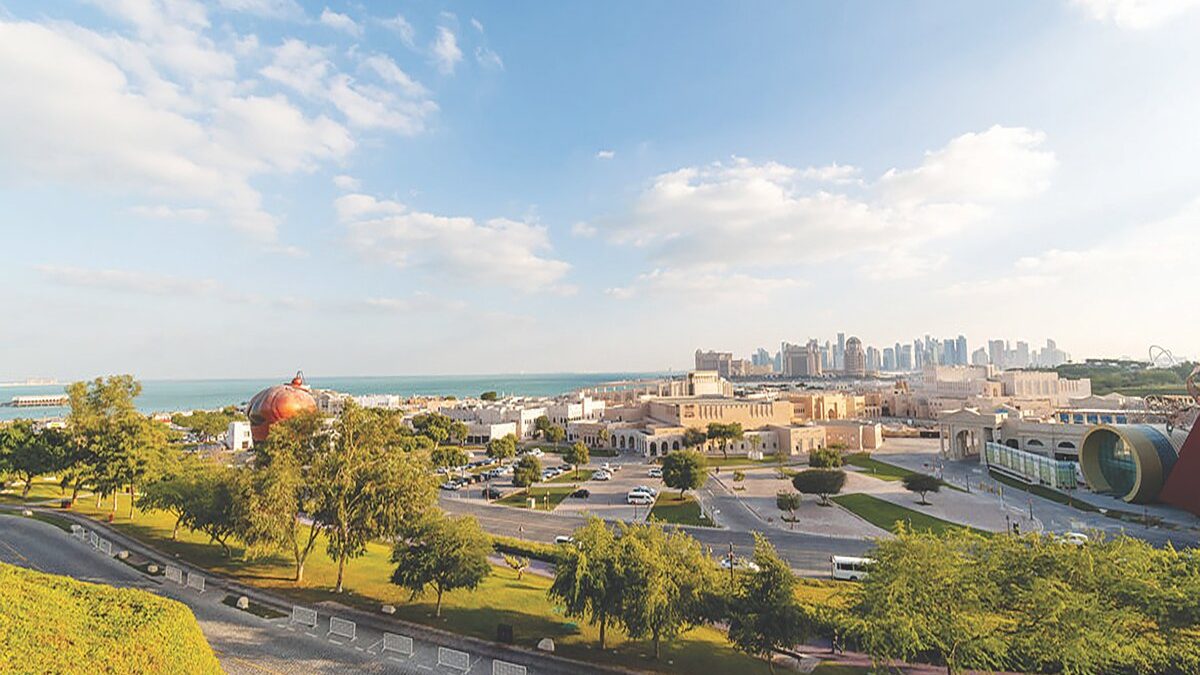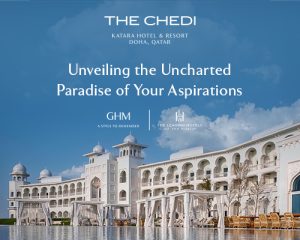Sitting on the waterfront, just a few kilometres north of Al Dafna, Katara Cultural Village is one of Doha’s premier attractions, with something to entertain both residents and visitors alike.
Founded in 2010 under the direction of the Father Amir, HH Sheikh Hamad bin Khalifa Al Thani, the Cultural Village Foundation’s (Katara) aim is to position Qatar on the international, regional and local stage for art, music, theatre, photography and more.
Some form of the name ‘Katara’ has long been used to represent Qatar. The country was first known as ‘Catara’, according to the map drawn by the geographer Claudius Ptolemaeus in 150 CE, published in 882 CE – 1477 CE and afterwards the Historical Atlas of Islam. It also gave the geographical location of the Qatar peninsula under the name of Catara, North West of Gerra or near it, and to the west of the town of Cadara. ‘Catara’ became ‘Katara’ after it appeared on the geographical and historical maps of the early 18th century, first depicted in a French map of the Arabian peninsula coastline, sea and gulf. It was decided to revive Qatar’s old name to maintain the connection to the country’s heritage.
Today, the multidimensional project brings together all the cultures of the world, with festivals, exhibitions and art galleries, and other cultural events. Adhering to the goals laid out in Qatar National Vision 2030, Katara preserves the heritage and traditions of the country while also embracing those of other nations.
When in Katara, you cannot miss the Pigeon Towers. Three are located near the Katara Masjid and the others are near Tasty Street. Pigeons and other birds can rest within the holes of the towers, which can house up to 14,000 birds. Katara also provides water and food to the pigeons. Constructed of unfired mud brick, lime plaster and gypsum, the towers range from 10 to 22 m in diameter and stand at least 18 m high.
The Katara Amphitheatre is an architectural masterpiece based on the classical Greek theatre and Islamic features with seating for 5,000 spectators, who over the years have been treated to many open-air concerts and film screenings.
In addition to its exquisite architecture and captivating graffiti, Katara is home to many visual masterpieces. Just outside the ampitheatre stands Lorenzo Quinn’s The Force of Nature II. The bronze, stainless steel and aluminium sculpture also appears in London and New York and is a piece created in the wake of the 2009 tsunami in the Pacific Ocean. Look out for Gandhi’s Three Monkeys by Subodh Gupta. Three sculptures show heads wearing military gear. Each piece is made up of cooking appliances, buckets and glass bowls, and are based on Gandhi’s famous visual metaphor – the three wise monkeys that ‘see no evil, hear no evil, speak no evil’.
For music fans, the Katara Opera House at Building 16 is home to the Qatar Philharmonic Orchestra, a member of Qatar Foundation (QF), as well as hosting other concerts. The orchestra performs and promotes Western and Arabic music with several performances a year at the opulent Opera House, which blends modern architecture with traditional Islamic design. qatarphilharmonicorchestra.org
Building 16 also houses Katara’s Drama Theatre, with traditional Arabic architecture bringing a sense of being out in the open air to the stage. It is used for plays and film screenings, with separate space for receptions and functions before and after performances. There are also a number of halls and galleries available to use for conferences, seminars and exhibitions.
Designed by globally-known Turkish mosque designer, Zeynep Fadillioglu, the Katara Masjid, which is also known as the Blue Mosque, is one of the most beautiful in Qatar. The decorations of the Masjid (which means ‘mosque’) were designed by a team of restoration specialists from Dolmabahçe Palace in Istanbul. The outer surface is lavishly adorned with turquoise and purple mosaic. The interior and exterior architecture, together with the minaret, the dome, and the prayer niche (mihrab) are inspired by famous mosques in cities of the Muslim world. Meanwhile the Golden Masjid is inlaid with tiny golden chips, representing the Ottoman style.
Visitors are welcome to walk in and see for themselves the architectural wonder of these mosques. Both offer religious programmes and lectures delivered by prominent religious scholars, as well as courses in Quran memorisation for children of all ages.
The Katara Publishing House promotes culture, knowledge and literature in Qatar. To date, Katara Publishing House has published over 100 books, including 60 novels in Arabic, English and French. Katara Publishing House can be found next to Building No 15, near the Amphitheatre Boulevard. kataraph.com
The 1.5 km Katara Beach is perfect for relaxing and to partake in one of the many beach activities, such as parasailing or kneeboarding. Admission prices changes per season. Separate fees apply for watersports and lessons. In addition, Katara Beach Club by LivNordic Spa & Wellness is gender separated over two floors with a gym, fitness studios and treatment rooms including their signature snow room, saunas and salt rooms. Inspired by the Aurora Borealis, the relaxation areas have a fireplace.
Katara has a 38,000 sq m outdoor luxury shopping complex, 21 High Street (Katara Plaza), which is home to Galeries Lafayette Doha, and the upcoming first Evian Spa in the Middle East. 21highst.net
As part of 21 High Street, the first dedicated unique present-shaped Children’s Mall is the new OliOli® Doha, an experiential children’s play museum where hands-on activities inspire positive play with six spaces: Kinetic Gallery, Water Gallery, Fitness Gallery, teamLab Future Park, Creative Lab, and WonderSphere. olioli.qa
The 361,500 sq m Katara Hills is divided into Northern and Southern Hills with at least 3,300 plants and trees, featuring gardens and green meadows with manmade rolling hills, valleys, peaks, water features, play areas, exercise and jogging tracks, with bespoke urban art installations, lighting, outdoor furniture, and signages. There is also an outdoor Padel Garden where the public can register to play the unique racket sport. Katara Hills also houses the new and opulent Katara Hills Doha, Lxr Hotels & Resorts, which includes 15 grandeur villas, each with a private pool, in addition to luxury facilities such as a spa and an Indian restaurant.
Dubbed as Qatar’s most luxurious cinema, the new Katara Cinema in Building 49 features four theatres, including platinum for two people, and a lounge for four people with high-tech amenities with ticket prices starting at QAR185 per person.
Also new to Katara is The Chedi Hotel & Resort, which is a luxurious boutique hotel with 59 rooms and suites, and 32 villas and chalets, featuring terraces with views over the city’s skyline, private pools, landscaped gardens and between one and five bedrooms. Facilities include a swimming pool alongside the beachfront promenade, a stunning infinity pool at the resort’s family-friendly beach club, and an expansive spa and fitness centre.
And more…
Katara continues to grow in both size and amenities. Phase IV, also known as the Southern Expansion Project and which began in 2016, has been recently completed. The unique mixed-use development consists of a wide range of facilities to complement those already offered at Katara, with 12 buildings and further parking spaces. The buildings house a chain of restaurants and cafes, libraries, exhibition hall, cinema and other cultural centres such as the first planetarium and astronomical observatory in Qatar, Al Thuraya Planetarium.
From Tasty Street to the restaurants along the beach, Katara is a gastronomic fine dining destination for cuisines from around the world including Greek, Indian, Egyptian and more. See the Katara map for where to eat at the village.
Katara is a cultural beacon of art, radiating in the Middle East through theatre, literature, music, visual arts, festivals, conventions, exhibitions, lectures and other cultural programmes.
182 or 4408 0000, katara.net, The Katara app is available on iOS and Android









